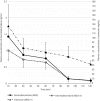Effects of vatinoxan on cardiorespiratory function and gastrointestinal motility during constant-rate medetomidine infusion in standing horses
- PMID: 30793362
- PMCID: PMC6767159
- DOI: 10.1111/evj.13085
Effects of vatinoxan on cardiorespiratory function and gastrointestinal motility during constant-rate medetomidine infusion in standing horses
Abstract
Background: Medetomidine suppresses cardiovascular function and reduces gastrointestinal motility in horses mainly through peripheral α2 -adrenoceptors. Vatinoxan, a peripheral α2 -antagonist, has been shown experimentally to alleviate the adverse effects of some α2 -agonists in horses. However, vatinoxan has not been investigated during constant-rate infusion (CRI) of medetomidine in standing horses.
Objectives: To evaluate effects of vatinoxan on cardiovascular function, gastrointestinal motility and on sedation level during CRI of medetomidine.
Study design: Experimental, randomised, blinded, cross-over study.
Methods: Six healthy horses were given medetomidine hydrochloride, 7 μg/kg i.v., without (MED) and with (MED+V) vatinoxan hydrochloride, 140 μg/kg i.v., followed by CRI of medetomidine at 3.5 μg/kg/h for 60 min. Cardiorespiratory variables were recorded and borborygmi and sedation levels were scored for 120 min. Plasma drug concentrations were measured. The data were analysed using repeated measures ANCOVA and paired t-tests as appropriate.
Results: Initially heart rate (HR) was significantly lower and mean arterial blood pressure (MAP) significantly higher with MED compared with MED+V. For example at 10 min HR (mean ± s.d.) was 26 ± 2 and 31 ± 5 beats/minute (P = 0.04) and MAP 129 ± 15 and 103 ± 13 mmHg (P<0.001) respectively. At 10 min, cardiac index was lower (P = 0.02) and systemic vascular resistance higher (P = 0.001) with MED than with MED+V. Borborygmi were reduced after MED; this effect was attenuated by vatinoxan (P<0.001). All horses were sedated with medetomidine, but the mean sedation scores were reduced with MED+V until 20 min (6.8 ± 0.8 and 4.5 ± 1.5 with MED and MED+V, respectively, at 10 min, P = 0.001). Plasma concentration of dexmedetomidine was significantly lower in the presence of vatinoxan (P = 0.01).
Main limitations: Experimental study with healthy, unstimulated animals.
Conclusions: Vatinoxan administered i.v. with a loading dose of medetomidine improved cardiovascular function and gastrointestinal motility during medetomidine CRI in healthy horses. Sedation was slightly yet significantly reduced during the first 20 min.. The Summary is available in Portuguese - see Supporting Information.
Keywords: MK-467; horse; medetomidine; sedation; vatinoxan; α2-antagonist.
© 2019 The Authors. Equine Veterinary Journal published by John Wiley & Sons Ltd on behalf of EVJ Ltd.
Figures




Similar articles
-
Effects of vatinoxan on cardiorespiratory function, fecal output and plasma drug concentrations in horses anesthetized with isoflurane and infusion of medetomidine.Vet J. 2019 Sep;251:105345. doi: 10.1016/j.tvjl.2019.105345. Epub 2019 Jul 27. Vet J. 2019. PMID: 31492389
-
Cardiovascular and sedation reversal effects of intramuscular administration of atipamezole in dogs treated with medetomidine hydrochloride with or without the peripheral α2-adrenoceptor antagonist vatinoxan hydrochloride.Am J Vet Res. 2019 Oct;80(10):912-922. doi: 10.2460/ajvr.80.10.912. Am J Vet Res. 2019. PMID: 31556714
-
Effects of intramuscular vatinoxan (MK-467), co-administered with medetomidine and butorphanol, on cardiopulmonary and anaesthetic effects of intravenous ketamine in dogs.Vet Anaesth Analg. 2020 Sep;47(5):604-613. doi: 10.1016/j.vaa.2020.05.008. Epub 2020 Jun 11. Vet Anaesth Analg. 2020. PMID: 32682664
-
A review of the physiological effects of alpha2-agonists related to the clinical use of medetomidine in small animal practice.Can Vet J. 2003 Nov;44(11):885-97. Can Vet J. 2003. PMID: 14664351 Free PMC article. Review.
-
Classics in Chemical Neuroscience: Medetomidine.ACS Chem Neurosci. 2024 Nov 6;15(21):3874-3883. doi: 10.1021/acschemneuro.4c00583. Epub 2024 Oct 15. ACS Chem Neurosci. 2024. PMID: 39405508 Free PMC article. Review.
Cited by
-
General Anesthesia Induced by a Combination of Medetomidine/Vatinoxan with Ketamine and Buprenorphine-ER in C57BL/6J Mice (Mus musculus).J Am Assoc Lab Anim Sci. 2024 Nov 1;63(6):675-682. doi: 10.30802/AALAS-JAALAS-23-000120. J Am Assoc Lab Anim Sci. 2024. PMID: 39237287 Free PMC article.
-
Dexmedetomidine Has Differential Effects on the Contractility of Equine Jejunal Smooth Muscle Layers In Vitro.Animals (Basel). 2023 Mar 10;13(6):1021. doi: 10.3390/ani13061021. Animals (Basel). 2023. PMID: 36978562 Free PMC article.
-
Clinical Effect of Acupuncture Combined with Traditional Chinese Medicine Application on the Treatment of Functional Dyspepsia in Children and the Influence on Serum 5-HT and NO Levels.Comput Intell Neurosci. 2022 Mar 31;2022:6800662. doi: 10.1155/2022/6800662. eCollection 2022. Comput Intell Neurosci. 2022. Retraction in: Comput Intell Neurosci. 2022 Dec 18;2022:9875174. doi: 10.1155/2022/9875174. PMID: 35401711 Free PMC article. Retracted.
-
Cardiorespiratory, Sedative and Antinociceptive Effects of a Medetomidine Constant Rate Infusion with Morphine, Ketamine or Both.Animals (Basel). 2021 Jul 13;11(7):2081. doi: 10.3390/ani11072081. Animals (Basel). 2021. PMID: 34359209 Free PMC article.
-
Fluid Resuscitation for Refractory Hypotension.Front Vet Sci. 2021 Mar 10;8:621696. doi: 10.3389/fvets.2021.621696. eCollection 2021. Front Vet Sci. 2021. PMID: 33778035 Free PMC article. Review.
References
-
- Pertovaara, A. (1993) Antinociception induced by α2‐adrenoceptor agonists, with special emphasis on medetomidine studies. Prog. Neurobiol. 40, 691‐709. - PubMed
-
- Bettschart‐Wolfensberger, R. , Clarke, K.W. , Vainio, O. , Aliabadi, F. and Demuth, D. (1999) Pharmacokinetics of medetomidine in ponies and elaboration of a medetomidine infusion regime which provides a constant level of sedation. Res. Vet. Sci. 67, 41‐46. - PubMed
-
- Ranheim, B. , Risberg, A.I. , Spadavecchia, C. , Landsem, R. and Haga, H.A. (2015) The pharmacokinetics of dexmedetomidine administered as a constant rate infusion in horses. J. Vet. Pharmacol. Ther. 38, 93‐96. - PubMed
-
- Bettschart‐Wolfensberger, R. , Bettschart, R.W. , Vainio, O. , Marlin, D. and Clarke, K.W. (1999) Cardiopulmonary effects of a two hour medetomidine infusion and its antagonism by atipamezole in horses and ponies. Vet Anaesth. Analg. 26, 8‐12.
-
- Flacke, J.W. , Flacke, W.E. , Bloor, B.C. and McIntee, D.F. (1990) Hemodynamic effects of dexmedetomidine, an α2‐adrenergic agonist, in autonomically denervated dogs. J. Cardiovasc. Pharmacol. 16, 616‐623. - PubMed
Publication types
MeSH terms
Substances
Grants and funding
LinkOut - more resources
Full Text Sources
Molecular Biology Databases

